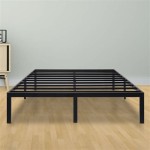Full Versus Queen Bed: Essential Aspects to Consider
Navigating the world of bedding can be perplexing, especially when choosing between a full and queen bed. Both offer distinct advantages and drawbacks, and understanding their key differences is crucial for a restful night's sleep. This guide will delve into the essential aspects of full and queen beds to help you make an informed decision.
Size and Dimensions
Size is the primary distinction between a full and queen bed. A full bed, often known as a double bed, measures 54 inches in width and 75 inches in length. It provides ample space for a single sleeper or a couple with limited room.
A queen bed, on the other hand, is significantly larger, measuring 60 inches in width and 80 inches in length. It offers more room for couples, those who prefer a spacious sleeping area, or individuals who frequently share their bed with pets.
Sleeping Capacity
The sleeping capacity is another crucial consideration. A full bed is typically suitable for one person or two individuals who are petite or prefer a cozy sleeping environment. However, it may feel cramped for larger couples or those who require more space to move around.
A queen bed, in contrast, provides ample room for two adults, even if they are on the larger side. It allows for comfortable sleeping arrangements, prevents tossing and turning, and minimizes the likelihood of disturbance.
Comfort and Support
Comfort and support are paramount for a good night's sleep. The firmness and construction of a bed significantly impact how well it supports your body and alleviates pressure points. Both full and queen beds can be found in various firmness levels, from soft to firm.
The choice of firmness depends on personal preferences and sleeping position. A softer mattress may be more suitable for side sleepers, while a firmer one provides better support for back and stomach sleepers.
Mattress Types
Full and queen beds accommodate a wide range of mattress types, including foam, innerspring, hybrid, and adjustable beds. Each type offers unique benefits and drawbacks.
Foam mattresses provide pressure-relieving comfort and motion isolation, while innerspring mattresses offer more support and breathability. Hybrid mattresses combine the advantages of both foam and innerspring, and adjustable beds allow for customized support and positioning.
Cost and Availability
Cost and availability are important factors to consider when purchasing a full or queen bed. Full beds are generally more affordable than queen beds due to their smaller size. However, queen beds are more widely available and offer a wider selection of styles and features.
The cost of a bed can also vary depending on factors such as the mattress type, materials used, and brand reputation.
Conclusion
Choosing between a full and queen bed depends on several factors, including size, sleeping capacity, comfort and support, mattress type, and budget. A full bed is a suitable option for single sleepers or couples with limited space, while a queen bed provides more room and comfort for couples or those who prefer a spacious sleeping area.By carefully considering these essential aspects, you can make an informed decision that will ensure a restful and rejuvenating night's sleep for years to come.

Full Vs Queen Size Bed 2024 Mattress Nerd

Official Full Vs Queen Mattress Comparison Puffy

Full Vs Queen Size Mattress What Is The Difference Nectar Sleep

A Detailed Guide On Full Vs Queen Size Mattresses Which One Should You Sleep Turmerry

Full Vs Queen Bed Size Difference Comparison Sleep Advisor

Queen Vs Full What S The Difference Sleep Junkie

Full Vs Queen Mattress What S The Difference Eachnight

Full Vs Queen Complete Mattress Size Guide Comparison

Twin Vs Full Queen Which Mattress Size Is Right For You Amerisleep

Twin Vs Full Queen Which Mattress Size Is Right For You Dreamcloud







